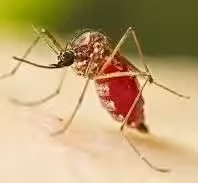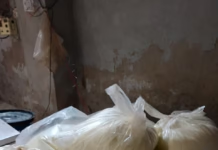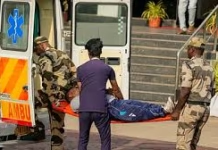Handling Dengue Crisis: there are four dengue viruses; Asprin and NSAIDS should be avoided: Dr. Ajit S. Puri
Dr Ajit Singh Puri/ November 12,2024
Dengue is a serious tropical disease and with the rise of its incidence over the years, it has become a global threat. It is the most widespread viral infection transmitted by the bite of Aedes aegypti mosquito that acts merely as a vector i.e. it only carries the virus responsible for dengue but does not suffer from it. The mosquito becomes infected when it bites a patient suffering from dengue.
There are four dengue viruses: 1, 2, 3, 4, those are closely related but interestingly infection with one provides life-long immunity to that virus only but not to others. This is one of the causes of spread of infection i.e. the person who has once suffered from the disease may again get it with another type of virus and so on. The most important cause of global spread is through air travel by infected persons.
What is Dengue Fever (DF) also called Break-bone Fever
Once the person is infected, the symptoms of the disease my start within 3 to 14 days called the incubation period (that is the interval between exposure to infection and the appearances of first symptom).
Patient gets sudden rise in fever, chills, headache, backache, retro-orbital pain i.e. pain behind the eyes that worsens with eye movements along with generalized severe muscle pain (myalgia) and hence the disease is called ‘break-bone fever. Another interesting feature of the disease is that the fever may be biphasic in some of the cases i.e. the fever subsides for few hours to 2 days and returns again lasting for 1-2 days with above symptoms though mild in nature. The disease may last for about a week. A macula-papular/measles-like (morbiliform) rash appears on the chest and back spreading to the face and limbs persisting for 1-5 days. Nausea, vomiting, loss of appetite etc. may also appear. On examination the pulse may be slow and glands may be palpable.
On routine testing the blood sample, one will find total leukocyte count low (leucopenia) with classical decrease in neutrophils (neutropenia). Much more important feature of the disease would be fall in platelet count (thrombocytopenia) and it may be responsible for mild bleeding disorders like scattered petechiae haemorrhages (small red spots on the skin), nose bleed etc.in some of the uncomplicated cases.
Dengue Haemorrhagic Fever (DHF)
It is a disease of children or young adults. In this condition the platelet count becomes markedly low. The normal platelet count is 150,000 to 450,000 /μL and any count below 1 00,000/μL is considered dangerous (and much more if the count is below 40, 000 μL). Low platelet count may be responsible for more and more bleeding episodes like blood in urine, in the gastro-intestinal tract (leading to vomiting of blood/ blood in stools) and in females menstrual bleeding may be enhanced. Platelets are necessary for effective blood clotting.
Tourniquet test (showing the bleeding tendency in the patient) may be positive. It is performed by inflating the blood pressure cuff midway between systolic and diastolic pressure for 5 minutes. If more than 20 petechiae per 2.5cm sq. are present the test is positive. Leakage of plasma (that is the fluid part of the blood in which red and white blood cells float) is the most characteristic feature of DHG and this determines the severity of disease and differentiates it from DF. It is due to the involvement of blood vessel walls (endothelium dysfunction) leading to increased vascular permeability. As such, fluid may accumulate in peritoneal/abdominal cavity called ascites and/or in the pleural cavity called pleural effusion. This causes depletion of fluid from the circulation and thereby decreased blood supply to the vital organs. The disease usually begins with sudden rise of temperature besides other features of DF.
Dengue Shock Syndrome (DSS)
This is the terminal stage of the disease. In this condition, there is marked circulatory failure with low blood pressure. The patient enters the shock stage in which there is severe pain in the abdomen, persistent vomiting, and marked uneasiness. The fever suddenly falls to below normal levels and the patient perspires profusely. These are the important warning signals and if detected in time and properly treated in the ICU (intensive care unit) of a well-equipped hospital, the life of the patient may be saved. Hence the need for caution. It may be noted that in DHF/DSS, patient responds well to supportive treatment.
Laboratory Tests
As mentioned above, there shall be low total leukocyte count (leukopenia), low neutrophils (neutropenia) as well as low platelet count (thrombocytopenia). Diagnosis is confirmed by IgM antibody and its rising titre is much more specific. It is a dengue virus-specific antibody. Newer tests like RT-PCR are much more specific as well as sensitive. Virus from the blood can be obtained during the period of fever for about five days after the symptoms begin. Serum aminotransferase may be elevated in many cases. Early fluid in pleural cavity (pleurisy) can be detected by ultrasonography. Likewise fluid in peritoneal cavity (ascites) can be detected.

How to manage a case of dengue
If there is no bleeding and loss of fluids by vomiting etc, the patient can be managed at home. For fever and pain, paracetamol may be given but asprin and NSAIDS (non-steroidal anti-inflammatory drugs) should be avoided due to the risk of bleeding. Patient should be given rest and fluids orally like oral rehydration solution, soups, juices etc. This will prevent dehydration due to vomiting and high grade fever. Sponging may be done to reduce fever.
However, while treating at home, one should be alert to any sign of shock like abdominal pain, persistent vomiting, bleeding, sudden fall of fever and blood pressure. This shows that the patient is entering the DSS. At such a stage the patient should be immediately shifted to a well equipped hospital with ICU facilities. Early detection at this stage can save the life of the patient.
In the hospital, oxygen, intravenous fluids of various types are given to maintain blood pressure and to manage loss of fluids. Above all a careful watch is to be kept on the number of platelets. As stated above safe count is above 40, 000 /μL. If there is spontaneous bleeding and the platelet count is lowering, say to less than 20, 000/μL, platelet rich plasma (PRP) ought to be given to save the life of patient. Many such units may be required. In selected cases, fresh blood may be given. Likewise fresh frozen plasma is administered. It is only plasma with no platelets. It helps to control bleeding as it contains coagulant factors. In some cases, though costly, platelet infusion may be required. Likewise, single donor platelet transfusion may be given. In this case platelets of donor are separated and transfused to the patient.
What is Chikungunya?
Its reference is important here as chikungunya virus is transmitted by the same mosquito which is responsible for DF i.e. Aedes aegypti. Its symptoms are also like DF. But unlike dengue, there is no bleeding episodes or shock syndrome. However, IgM test needs to be done to distinguish it from DF. It is a self-limited disease and needs only symptomatic treatment with rest, oral fluids. sponging, paracematol, avoiding asprin and NSAIDS.
Prevention:
Mosquitos that transmit dengue virus live among human beings. They breed in water storage containers, flower pots, discarded tires, old drums etc. lying close to human dwellings. They bite during the ‘day. The following are some of the guidelines for prevention:
- Eliminate mosquito breeding sites in and around homes. Discard items that can collect rain or run-off water. Regularly change water from coolers. Likewise regularly change the water kept outdoor in various containers for birds, pets and animals. In a nutshell, stagnant water in and around homes should be avoided. Insect repellents may be used.
- When moving outside, wear long-sleeve shirts, long trousers and socks. One should try to avoid heavy populated, unhygienic, residential places. Also use insect repellent on uncovered parts of the body.
- When indoor, try to stay well cleaned and if possible, air conditioned rooms. Space-spray insecticides and mosquito-nets may be used while sleeping.
- Infants need much more specialized precautions.
NOTE: The views expressed are personal. The Author: Dr. Ajit S. Puri, MBBS, MD (Medicine), FICP, FCAI, FICA, DSc. (Honoris Causa) is a Patiala – based Medical Specialist. He is the author of the world acclaimed book How to Prevent Common Diseases that has been appreciated by the World Health Organization, Geneva and is running in more than 40 countries.
He has the experience of dealing with dengue emergencies in Mohan Dai Oswal Cancer Hospital, Ludhiana. He can be contacted: 09316220136 (mob). E.mail: [email protected]













